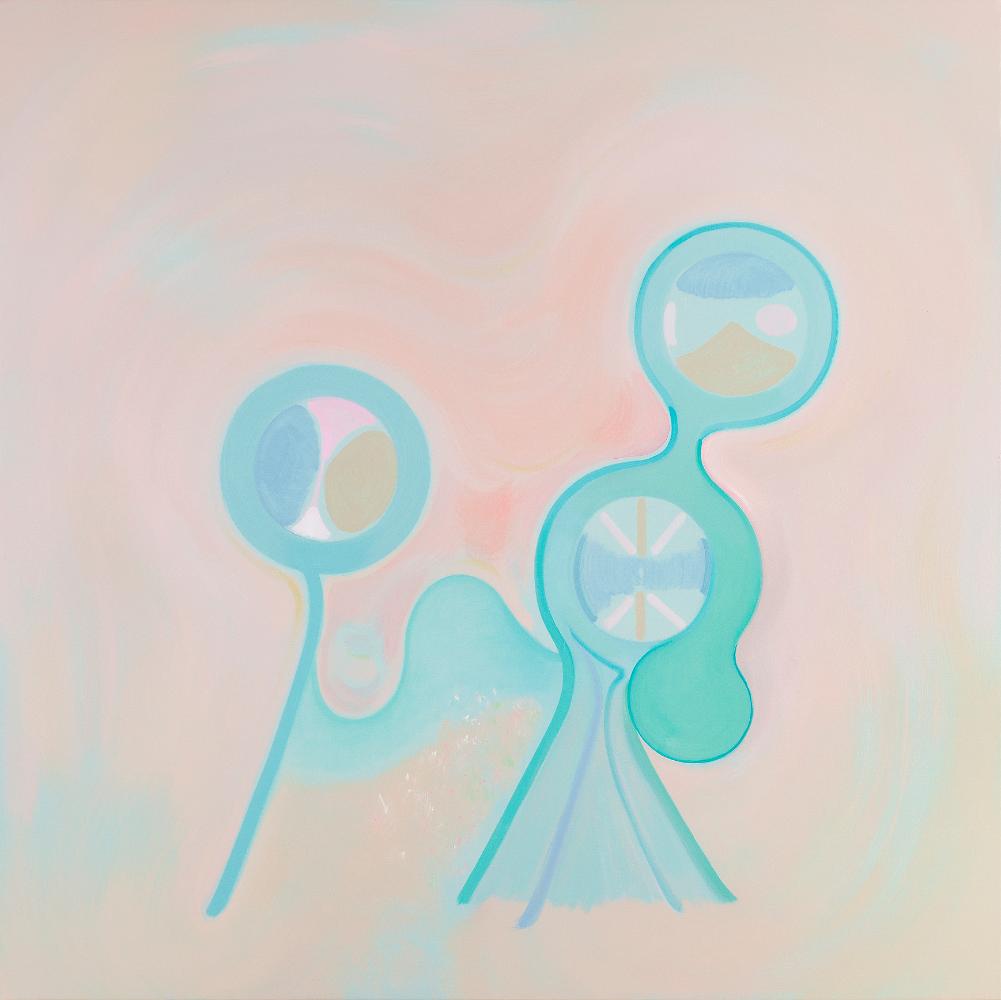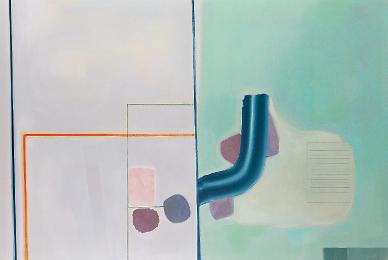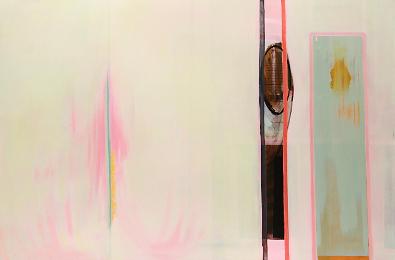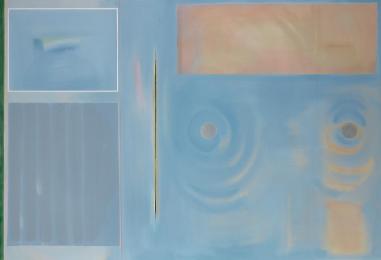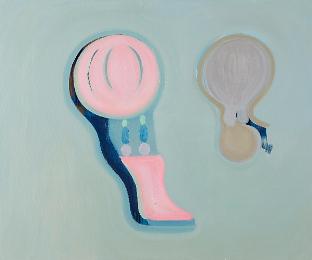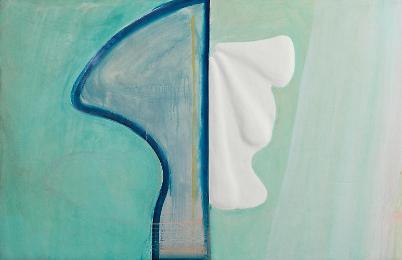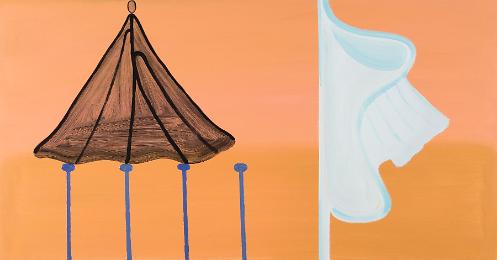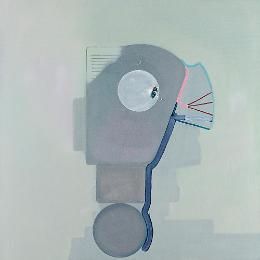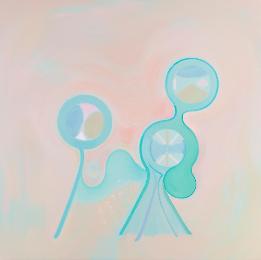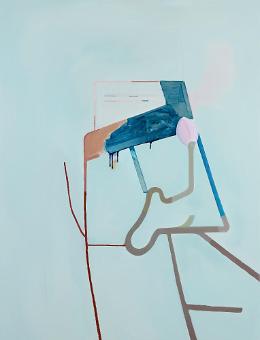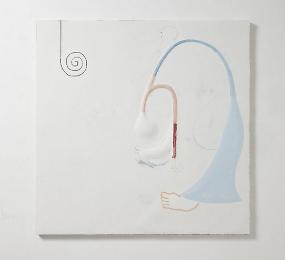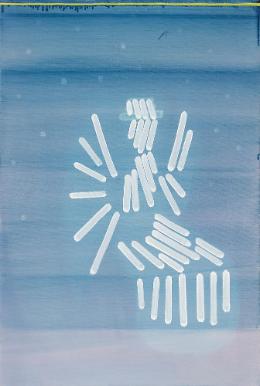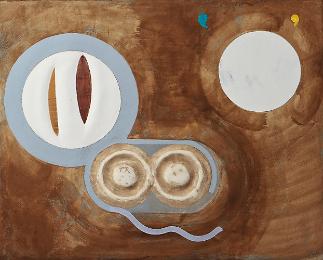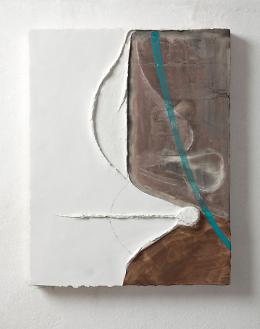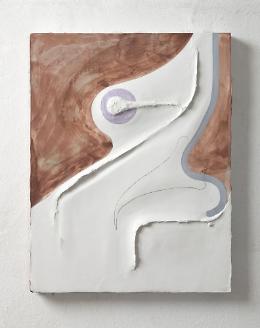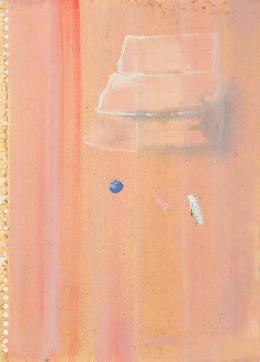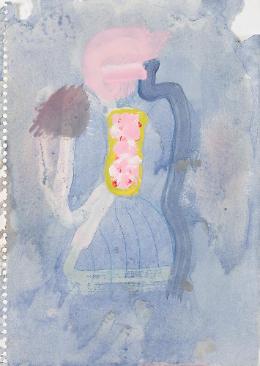글. 정현 (미술 비평)
기억은 연대기적 시간의 방향을 따르지 않는다. 갑작스레 어린 시절의 기억이 자신의 생각을 지배하는 경우를 누구나 한번쯤 경험하지 않은가. 마르셀 프루스트의 소설은 사물, 상황, 오감이 비자발적으로 촉발시킨 기억의 반란으로 시작된다. 지나치게 예민한 감수성의 프루스트는 이 경험 안에서 삶과 수많은 관계가 기호들로 채워진 물음의 장소라는 사실을 깨닫는다. 삶은 결정되지도 완성되지도 않은 상태로 스스로 이 모든 수수께끼를 풀어나가는 과정이라고 프루스트는 얘기한다. 기억의 반란으로 익숙한 대상은 갑자기 낯선 것이 되어버리고 희미한 기억이 자신 앞에 등장한다. 하지만 바쁜 일상 속에서 어떤 대상으로부터 기억의 흔적을 더듬는 사유의 과정으로 깊숙이 빠져들기란 그리 쉬운 일이 아니다. 기억의 흐름을 되짚어가기 위해서는 불확실하고 모호한 정보의 단서들, 그 추상적인 움직임, 이미지, 색채 혹은 질감을 연상해내야만 하기 때문이다. 마치 방금 지나간 봄날의 훈훈함과 향기처럼 또렷하게 떠올려지지 않으나 온몸으로 감지되는 무언가를 연상할 수 있는 것처럼 말이다. 이민정의 <상기하다>는 기억에 관한 전시다. 갑자기 부상하는 어떤 기억에 관한 내적 경험을 작가는 단어 “상기 reminiscence”로 함축했다. 어렴풋한 기억이란 의미를 가진 “reminiscence”는 선험적 기억 또는 전생의 기억 같은 것으로 데자뷰 현상과 같이 우발적으로 떠오르는 기억을 지시한다. <상기하다>는 바라보기보다 사색하는 그림을 경험하는 전시다.
모든 것이 느리게 움직였다. 첫 만남에서의 화가 이민정의 모습에서 ‘느려진 시간’이 연상되었다. 표현도 서툴렀다. 표정은 애매했다. 다소곳하지만 질문 하나하나에 집중하는 모습은 꽤 인상적이었다. 마치 셀 수 없이 많은 생각들을 꼭꼭 담아놓은 저장소에서 질문에 알맞은 답을 한참이나 뒤적거려 꺼내는 듯했다. 조용한 목소리였지만 자신이 내뱉는 단어를 꾹꾹 눌러 말하는 것처럼 들렸다. 작업에 관해서는 특별한 창작의 원천도, 기술적인 특이함도 없다고 얘기하지만 한편으론 자기만의 세계를 남에게 보이고 싶지 않은 것처럼도 느껴졌다. 마치 언어에 의해 자신을 축소시키지 않기 위해 노력하는 것처럼 보일 정도로 그는 말을 아끼고 설명되지 않는 생각을 담아내려 했다. 그는 새로운 회화보다 언어로 규정되지 않는 그림을 그리려 한다. 작업의 개념이나 모티브 역시 불확실하게 보였다. 좀더 작업과정에 가깝게 다가가보자. 우선 가장 단순하고 원초적인 형태인 점·선·면에 의해 탄생한 형태를 화면 위에 내놓는다. 시작의 형태들은 작업이 진행될수록 몇 차례의 변화를 겪는다. 확실한 개념이나 계획보다 우연히 나타난 형태들이 서서히 성장의 과정을 겪어가며 새로운 형태를 파생시키거나 지워지면서 화면은 점점 더 예측할 수 없는 미궁으로 변해간다. 작가 스스로 그림의 모티브에 관해서 방임적이라고 한 것은 작업의 본질이 의도한 결과를 재현하기보다 세계(화면) 안에 던져진 형태(생명체-유기체)의 진화과정에 방점을 두기 때문인 듯하다. 그는 의도하는 세계의 재현을 추구하기보다 작업 과정에 따라 자신 앞에 어떤 세계가 펼쳐지는 것을 즐기는 것처럼 보인다. 그림은 직선과 곡선이 서로 만나 만들어내는 의외의 형태가 주는 유희이자 색과 텍스처는 다양한 지각의 경험을 일깨운다. 그림은 무게나 온도와 같은 지각의 장이 되어 많은 것을 담을 수 있는 열린(또는 빈) 기억의 장으로 펼쳐진다. 보는 사람의 경험에 의해 그림은 무한의 기억을 발생시킬 수도 반대로 의미 없는 장이 될 수도 있다. 화면을 차지하고 있는 건 비정형적인 형태들과 여백뿐이다. 여백은 전체적으로 밝은 회색 톤으로 이루어져 있으나 간헐적으로 얼룩들이 아른거린다. 얼룩은 시간의 흔적이다. 최초의 형태 혹은 모티브는 시간이 경과하면서 서서히 배경으로 사라지면서 여백의 얼룩으로 남겨지거나 다시 되살아날 수도 있다. 마치 우발적인 기억의 등장이 꼬리를 물고 또 다른 기억으로 이동하는 발작적인 기억의 자율성처럼 여백의 얼룩은 그림의 탄생하던 시작의 기억을 품고 있다. 이민정에게 논리적이고 체계적인 방법론은 큰 의미를 가지지 않는다. 그렇다고 커다란 밑그림이 없는 것 같지는 않다. 그에게 한 점의 그림은 하나의 삶을 비유하는 듯하다. 마치 밀물과 썰물, 일출과 일몰의 주기적인 반복을 상기하듯 그의 그림은 한 화면 안에서 하루와 영원이 공존한다. 기억의 얼룩들은 먼 곳으로부터 기인한 여명처럼 ‘지금 여기’로 다가오는 중이거나 반대로 심연으로 사라지는 우주가 순환성을 담아내려는 흔적처럼 보인다.
예를 들어, 에바 헤세의 중력을 따르는 설치조형작업은 현존하는 어떠한 개념이나 양식에도 속하지 않는 상태를 좇았다. 그것은 늘 다른 중량, 다른 배치, 다른 기울기를 가질 수밖에 없었다. 적어도 헤세의 조형세계가 어떤 언어로도 대체되지 않는 직관과 경험에 의해 제시되었다는 점은 추상, 구상, 조각, 설치와 같은 언어가 실제 조형작업과 온전히 대입되지 않는다는 것을 알맞게 시사한다. 헤세의 현상학적 예술관은 시각에 머물렀던 미술에서 지각하는 원리의 미술로 확장되고 있음을 증명하고 있다. 현상학자 메를로-퐁티는 눈 앞에 펼쳐지는 광경이 곧 사유와 직관되는 것은 아니라고 지적한다. 그것은 조건부의 사유로 제한되며 실제로는 온몸으로 세계를 느낄 수밖에 없다. 하나의 광경은 그저 광경일 뿐 그 자체가 사유는 아니다. 지각의 경험은 사유 이전에 발생한다. 사유란, 지식의 체계에 따른 해석만으로 불충분하다. 우리의 지각이 자각으로 연장되려면 불가피하게 정신과 몸, 우주의 신비를 스스로 깨우치기 위한 의지가 필요하다. 메를로-퐁티는 “회화는 운동의 외부를 찾지 않고 그 비밀의 숫자를 캐묻는다”라고 말한다. 이민정의 그림이 흥미로운 것은 몸의 지각으로 인식하는 세계를 시각적으로 번역하는 데에 있다. 그는 그림의 표면을 피부, 살갗처럼 자주 표현한다. 온도에 대한 감각은 작품 전반에 걸쳐 나타난다. 이번 전시에서의 온도는 미지근함에 가깝다. 차가움과 뜨거움의 사이는 들뢰즈에 따르면 모든 것의 시작점이다. 중간의 세계, 고원의 삶을 희망하던 이 철학가에게 중간색이야말로 모든 것의 시작으로 수평적 세계관을 대변하는 것이었다. 내게 중간색의 모호함은 지워진 소리처럼 느껴졌다. 그것은 소리가 없음이 아니라 소리를 잠시 숨겨놓은 상태에 가깝다. 마치 수중처럼 육지와 다른 중력의 법칙이 적용되는 것과 유사하게 느껴졌다. 설명될 수 없는 이미지로써 추상회화는 언어가 가진 표현의 한계를 극복하려는 몸짓에 가깝다. 구조주의 인식론적 관점으로 본다면, 사적 인식이 결국 언어의 지배에 의한 것이기에 우리는 결국 언어 밖으로 탈출할 수 없다. 그러나 끊임없이 규범화된 언어를 해체하고 재배치하려는 시도는 시적 전복을 암시한다. 시적인 사유는 무질서가 아닌 질서 이전의 세계를 향한다. 원형에 다가가려는 의지는 모든 예술가의 바람일 것이다. 앞으로 이민정이 바로 그곳, 지나친 산업화와 자본화로 잊혀진 멀고도 가까운, 가깝고도 먼 그곳을 향한 여정을 계속되길 바란다.
Far yet Close, Close yet Far
Jung Hyun(Art Critic)
The memory does not follow the chronological direction of time. Everyone has once experienced their thoughts governed by childhood memories. A novel by Marcel Proust begins with the treachery of memories involuntarily triggered by things, situations, and the five senses. Proust with an extremely keen sensibility realizes life and its relations are filled with numerous signs within this experience. He states that life is neither determined nor completed but is a process of solving all riddles. Due to the treachery of memories, familiar objects suddenly become unfamiliar, and vague memories merge before us.
It is not easy to enter the process of thinking, groping for traces of memories triggered by some object in our hectic daily lives. Because of this we have to associate clues to uncertain, ambiguous information, abstract movement, images, colors, and texture in order to recollect the flow of memories. We recall something that is obscure yet sensed with the whole body like the warmth and fragrance of a spring day. Lee Min-jung’s Reminiscence is an exhibition concerning the memory. The artist connotes her inner experience of suddenly provoked with the term ‘reminiscence’. Like a-priori memories or memories of the past occurring accidentally like déjà vu. Works exhibited at the show are for meditating upon rather than viewing.
Everything moved slowly. Artist Lee reminded me of slowly flowing time at my first meeting with her. Her expression was not so eloquent and her look seemed obscure, but her concentration on each question was quite impressive. She seemed to draw out a proper answer from a reservoir of innumerable ideas. Her voice was low, but quite determined, underlining the meaning of each word. Although she explained there is no single source for her creation or any technical distinctiveness, I felt she would not like to showcase her own world. Lee remained silent as if to show that she does not confine herself with language.
Lee intends to make paintings not defined by language. The concept and motifs of her work are also vague. She presents forms made up of the most simple, primal elements such as dots, lines, and planes. Her initial forms undergo change several times in the process of her work. As the forms emerge by chance rather than by any concrete, solid concept and plan new forms come into being in the process of their gradual growth. The artist says she does not intervene in her work’s motif. This underscores the evolutionary process of forms (life forms-organisms) rather than representing any intentional result. She seems to enjoy discovering some world before her eyes rather than pursuing its representation.
Lee’s painting offers amusement derived from unexpected forms created through encounters of straight and curved lines. Their color and texture bring about diverse perceptual experiences. Her painting is an open (or empty) forum encapsulating many things. It may become a forum for infinite memories or a forum for meaningless things, depending on the viewer’s experience. Her painting is filled with atypical forms and blank space. The blank spaces are in a bright gray tone, but have some sporadic stains which are the traces of time. As time passes, initial forms or motifs vanish into the background or are left or revived as stains in blank spaces. The stains bear initial memories at the moment her painting comes into being like convulsive memories that morph into other thoughts. Any logical, systematic methodology is of no significance in Lee’s work. Nevertheless, her work probably depends on large rough sketches. In her painting a dot is compared to a life. Moment and eternity coexist in her painting, as if recalling the cycles of the tide coming in and going out. The stains of memory come close to ‘here and now’ or go to an abyss, encapsulating a circulating trait of the universe.
For instance, Eva Hesse sought a state of not being inclusive of any concept or mode through installation work. Her work had a certain weight, arrangements, and inclinations. The world of Hesse was based on her intuition and experience irreplaceable with language. Hesse’s view of art as phenomenological expands from art depending on sight to art relying on perception. Maurice Merleau-Ponty, French phenomenologist, pointed out that a scene before the eyes is not directly associated with thinking. With our thinking we feel only part. We actually feel the world with our whole bodies. A scene is just a scene. A scene itself is not thinking. An experience of perception comes into being before thinking.
Lee’s painting visually interprets the world perceived by the body. She presents the surface of her painting like skin. A sense of temperature is apparent in her oeuvre. The temperature sensed in works on show is tepid. For Gilles Deleuze all begins between cold and hot. For this philosopher desiring the middle world, or life on a plateau, a neutral tone is the onset of all, representing a horizontal view of the world. A neutral tone feels like a deleted sound. It is not a state without sound but close to a state hiding sound for a while, like gravity underwater.
Abstract painting with indescribable images is close to overcoming the limits of language. Seen from the epistemological view of structuralism, an individual’s perception is governed by language, so we cannot escape language. An attempt to deconstruct and rearrange standard language implies a poetic turn. Poetic thinking seeks a world before order. All artists probably have a will to approach original form. It is anticipated Lee will continue her journey toward the far, yet close, close yet far, and forgotten through industry and capitalism.

 작품을 클릭하시면 큰 화면으로 감상하실 수 있습니다.
작품을 클릭하시면 큰 화면으로 감상하실 수 있습니다.




